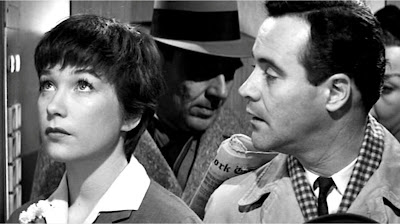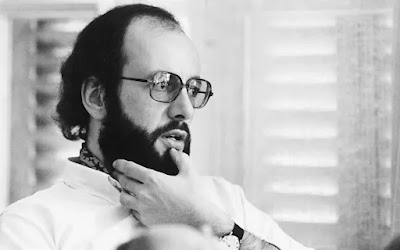Bertrand Blier, who has died aged 85, was a French filmmaker whose comedies – notably Les valseuses (Going Places, 1974) and Trop belle pour toi! (1989) – ranged from the provocative to the deeply politically incorrect. Almost as shocking now is that his oeuvre briefly synched with American tastes, landing him a Foreign Film Oscar for Préparez vos mouchoirs (Get Out Your Handkerchiefs, 1978).
Bearded and pipe-smoking, the broadly incorrigible Blier began making mischievous hay at a moment where the once-radical New Wave filmmakers were being viewed as loftily academic or simply old hat. The very title of Les valseuses, by contrast, formed an offence-intending mission statement, being as it was slang for the testes.
This galumphing road movie, which its maker framed as “a French Clockwork Orange”, centred on a pair of hitchhikers (Gérard Depardieu and Patrick Dewaere) traversing the countryside in search of girls and cheap thrills. Both were found; but even in 1974, viewers had to weigh the earthy humour against the brutish treatment of women (among them Jeanne Moreau and the young Isabelle Huppert), varyingly harassed, groped and set upon, often discarded at the roadside.
Among those objecting was the filmmaker Chantal Akerman, who personally picketed screenings, telling queuing punters the film was “an insult to women”. But it had admirers, too, including Pauline Kael, who compared the film to Ben Jonson’s farces and found the leads’ crude energy “joyous”: “Life to them is like a big meal: they go at it like hungry workmen tearing at a carcass of beef, with greasy fingers.”
Six million people saw it in France alone, enough for Blier to be offered the film rights to stage hit La Cage aux Folles. Turning them down (as he later rued: “I would have made billions”), he instead refined his approach to some degree. Despite having its unhappy housewife heroine (Carole Laure) impregnated by a 13-year-old boy, Préparez vos mouchoirs was comparatively respectable: Mozart on the soundtrack, Depardieu and Dewaere recast as clueless cuckolds.
Even so it provoked division: TV’s Siskel and Ebert vehemently disagreed, with the latter insisting the film “should be cut up to make ukulele picks”. Audiences and awards voters had to decide for themselves; the Oscar win, as Blier admitted, was unlikely – People magazine called it “downright incomprehensible” – but helped by Ingmar Bergman’s decision to pull Autumn Sonata (1978) from the Foreign Language Film category, following his battles with the Swedish tax authorities.
For a while, Blier risked respectability. Buffet Froid (1979) sent up the thriller genre – dispatching Depardieu after a missing penknife – and won the Best Screenplay César. The hits kept coming: La femme de mon pote (My Best Friend’s Girl, 1983), a vehicle for national treasure Coluche; and Tenue de soirée (Evening Dress, 1986), a bizarre love triangle putting Depardieu and Michel Blanc in drag.
Trop belle pour toi!, wherein Depardieu ditched trophy wife Carole Bouquet to shack up with mousy secretary Josiane Balasko, outdid them all, sharing the Cannes Grand Prix with Cinema Paradiso (1988) and winning five Cesars, including Best Film and Best Director. Again, many were surprised. Yet Blier maintained even this crowning achievement derived from a familiar French urge: “I’ve always enjoyed shocking the bourgeois.”
Bertrand Blier was born in Boulogne-Billancourt [now Hauts-de-Seine] on March 14, 1939, to the actor Bernard Blier and his wife Gisèle (née Brunet). He soon found himself surrounded by luminaries, recalling one trip where “every night my father and [Henri-Georges] Clouzot would smoke their pipes while playing chess”. His mother, however, prompted trickier memories: in Fragile des bronches, an autobiographical novel of 2022, Blier recalled seeing Gisèle on a windowsill, apparently considering suicide.
Blier once claimed he slashed his own wrists so to avoid serving in Algeria; instead, he found work as an assistant director to Jean Delannoy and Christian-Jaque. He debuted with Hitler, connais pas (1963), a documentary profiling post-war youth, before casting his father in the thriller If I Were a Spy (1967).
Blier followed Trop belle pour toi! with Merci la vie (1991) and Mon homme (1996), showcases for his then-partner Anouk Grinberg. Yet the new millennium saw a creative tail-off: all-star flop Les acteurs (1999) was followed by critical derision for the haranguing farce Les côtelettes (2003). Le bruit des glaçons (The Clink of Ice, 2010) drolly rebutted cancer-movie pieties, but there were few takers for Convoi exceptionnel (Heavy Duty, 2019), a final reunion with Depardieu.
Blier was among those signing a 2023 letter supporting the actor in the wake of rape and sexual harassment allegations; the accusations resulted in the cancellation of a planned 50th anniversary TV screening of the pair’s breakthrough film in early 2024. Sixteen years earlier, however, Blier recalled his first grab at infamy with obvious glee. “With Les valseuses,” he said, “I got my hands on France’s package.”
He is survived by his third wife, the actress Farida Rahouadj, and three children: one by Rahouadj, one from his relationship with Grinberg, and one by his second wife, the producer Catherine Blier Florin. His first wife was Francoise Vergnaud.
Bertrand Blier, born March 14, 1939, died January 20, 2025.











